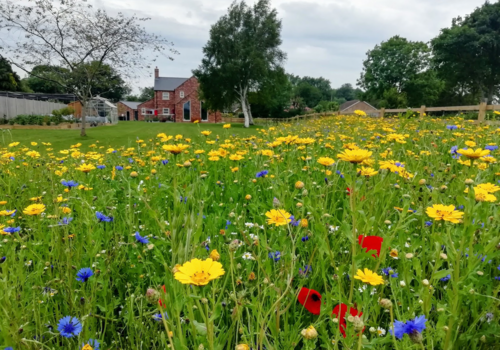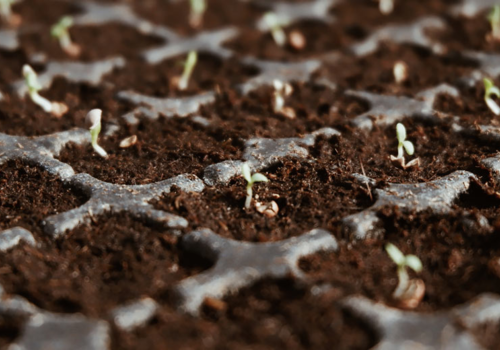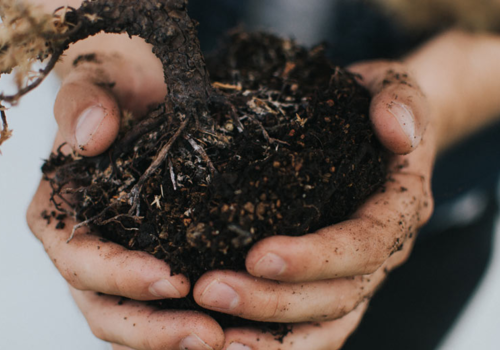
Once you’ve established your wildflower garden, it’s important to learn how to properly maintain it. A properly maintained wildflower garden will let you enjoy beautiful native wildflowers for years to come.
Wildflower plants are an important addition to your garden if you want to encourage biodiversity and help prevent the decline of pollinators such as bees and butterflies. Many of our wildflower seed mixes, like our Traditional Wildflower Seed Mix, have been recognised by the Royal Horticultural Society as featuring wildflowers proven to help prevent the decline of pollinators.
Wildflower plants are also able to thrive in conditions that many other flowers struggle to grow in. Wildflower plug plant mixes like our Dry Soils Wildflower Collection can grow in the driest of soils and are able to tolerate drought conditions. Wildflower plants can even grow in acidic soil as shown in our Acid Soils Wildflower Collection. This means whatever condition your garden is in, you can grow and maintain a beautiful wildflower meadow.
How do you look after a wildflower garden?
To keep your wildflower garden looking its best, you’ll need an annual maintenance plan.
While young wildflower plants are establishing themselves, the grass will need to be kept reasonably tidy. In the first year of sowing the nurse grasses will require cutting twice during the spring at 5cm. In the first summer, you can skip cutting them and then carry out two more cuts in the autumn at 5cm.
Once the wildflowers have established themselves during the second year, there is a slight change to the cutting regime. You’ll want to begin a regular summer cut from the second year onward. This cut is also known as the ‘hay cut’ and is done between June and August.
TOP TIP: It will depend on exactly which wildflowers you grow when you should cut it. Flowers like Cowslips favour cutting earlier, whereas flowers like Knapweed prefer to be cut later.
The first cut in the autumn should be done without the mower box attached, thus allowing the mature seed heads to shed their seed back into the soil.
After this, leave them for 2 to 3 weeks. During this time, the seed heads will dry out and release seed back into the soil, the final cut will tidy the whole area and remove any dead material.
Keeping your wildflower garden pruned will help promote healthier plants so you can enjoy a healthier, more colourful wildflower meadow.
Throughout the year, keep an eye out for any unwanted weeds in your wildflower garden. Certain weeds can be incredibly hardy and even if you think you’ve fully removed them, you might find them creeping back! Try to keep on top of this as they can steal valuable nutrients from wildflower plants and leave patchy areas across your wildflower meadow.
Do wildflowers die in winter?
Whether or not your wildflowers come back year after year will depend if you are planting annual wildflowers or perennial wildflowers.
Annual wildflowers live and die in a single growing season. This means you need to replant annual wildflowers every year. The main benefit of annual wildflower plants is that you can quickly establish your wildflower meadow. We have a range of annual wildflower seed mixes if you want to quickly enjoy a kaleidoscope of colour in your wildflower garden.
Perennial wildflowers will grow back year after year. They take longer to establish, and you will most likely only see green foliage without any flowers in the first year, but you won’t need to replant them.
To make sure you can enjoy the best of both worlds, many of our wildflower seed mixes, like our Restore & Enrich Wildflower Seed Mix, feature both perennial and annual wildflower plants.
How long does it take to establish a wildflower meadow?
The nurse grasses will be the first to establish within a few weeks, they’ll be fairly sparse to start as the wildflower seeds germinate in the spaces around the young grass seedlings.
The germination of wildflower species will vary - some may take only a few weeks, while others may take several months depending on the sowing time.
Depending on the mixture and time of year sown, it is unlikely that any of the perennial flowers will appear during the first year of establishment. Because perennials grow back year after year, they take longer to establish themselves within your wildflower mix. This doesn’t mean you can’t enjoy some colour during your first year of growing a wildflower garden though. It is possible to have a "splash" of colour during the first year if the Cornfield Annuals mixture is incorporated at the same time of sowing.
Read our guide to establishing a wildflower garden to learn more about how you can begin your own wildflower meadow.
Are wild flowers seasonal?
Wildflowers do have general growing seasons, but it’s important to note that they don’t follow the calendar, they follow the weather. If you are growing a wildflower plant that is known to flower in spring but it has been unseasonably cold, you may find you need to wait until the weather warms up again!
Wildflowers are generally pollinators, like our Bee and Butterfly Wildflower Seed Mix, so their life cycle is based around getting pollinated and dispersing their seeds before the cold winter months. This means they’ll try to flower in sync with when pollinating insects have begun to fly. When you start to hear the buzz of bees, you’ll probably start to see some of your wildflowers blooming!
Some wildflowers are known as early pollinators, which means they bloom especially early. Snowdrops for example are particularly popular early pollinators as they flower as soon as February. You can even buy snowdrop wildflower bulbs ‘in the green’ which are ready to be planted directly in your garden in the winter.
To ensure your wildflower garden can stay colourful year round, consider looking at a wildflower seed mix like our Dual Purpose Wildflower Seed Mix. This wildflower seed mix features wildflowers that flower between May and October, so you can enjoy your wildflower meadow for longer.
---------------------------
Have more questions about wildflower garden maintenance? Don’t hesitate to get in touch with a member of our friendly team.
---------
How we can help!
Why not add a splash of colour to your lawn edges this summer with our extensive range of wildflower seed mixes? March is the perfect time to plant wildflower seeds and you'll be spoilt for choice with the Boston Seeds selection!
At Boston Seeds we take pride in excellent customer service. If you're growing a lawn from scratch but unsure how much grass seed you need, our handy Grass Seed Calculator can help you figure it out in just a few clicks!
With Next Day Delivery on hundreds of items too, choosing from our extensive range of grass seed couldn't be easier. Ordering regularly or looking for large volumes? Click here to apply for a trade account today - we review all applications within one working day. If you have any questions, then please get in touch.


